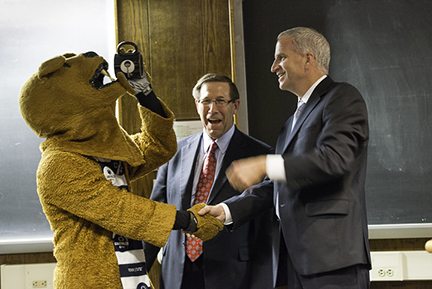IMAGE OF THE WEEK
 Interior perspective drawing for The C. Gregory Knight Collaborative Learning Lab, in room 229 Walker Building. The Knight Lab will be designed as a collaborative work space for undergraduate students. The design will continue the small-group collaboration and dynamic course structuring held dear by students that Knight fostered during his tenure in geography.
Interior perspective drawing for The C. Gregory Knight Collaborative Learning Lab, in room 229 Walker Building. The Knight Lab will be designed as a collaborative work space for undergraduate students. The design will continue the small-group collaboration and dynamic course structuring held dear by students that Knight fostered during his tenure in geography.
GOOD NEWS
Send your good news to share to geography@psu.edu.
NEWS
The Miller Lecture: Julie A. Winkler “Climate Change Impact Assessments for International Market Systems”
The vast majority of climate change impact assessments evaluate how local or regional systems and processes may be affected by a future climate. Alternative strategies that extend beyond the local or regional scale are needed when assessing the potential impacts of climate change on international market systems, including agricultural commodities. These industries have multiple production regions that are distributed worldwide and are likely to be differentially impacted by climate change.
- 3:00 to 5:00 p.m.
- Refreshments are offered in 319 Walker Building at 3:00 p.m.
- The lecture begins in 112 Walker Building at 4:00 p.m.
- Coffee Hour To Go
Researchers hunting for Pennsylvania’s orphaned and abandoned wells
Like any good hunter, Nooreen Meghani knows how to read the signs that her prey is close. But deep in the Allegheny National Forest, she’s not following animal tracks — or any sign of life for that matter. Instead she traces the path of an old metal pipe running along the forest floor.
Calls for submissions
- The Archaeological Review from Cambridge, an international, postgraduate run academic journal, is seeking submissions for Volume 31.2: Landscapes and People. This issue seeks to bring together a variety of methods of landscape studies, particularly those engaged in reconstructing ancient human landscapes. Abstracts of no more than 500 words describing your potential paper should be sent to Ian Ostericher (ido20@cam.ac.uk). The deadline for abstract submission is November 15, 2015. More information: http://www.societies.cam.ac.uk/arc/home.html
- As part of its twenty-fifth anniversary celebration, CLGBTE will sponsor an interdisciplinary academic symposium, showcasing current LGBT research and instruction conducted at Penn State by faculty and graduate students from across the University’s twenty-four campuses. The event will be held at the Hintz Family Alumni Center, University Park campus on Friday, April 22, 2016. Submissions pertaining to any aspect of LGBT/queer studies are being solicited from Penn State faculty and graduate students. The length of individual presentations should not exceed 20 minutes. Please send a title and summary (300 words maximum) of your presentation/paper, your academic title and affiliation, and a brief personal biography to Kim Bowmaster at ksg165@psu.edu.SUBMISSION DEADLINE: December 1, 2015. More information: http://equity.psu.edu/clgbte
RECENTLY (OR SOON TO BE) PUBLISHED
Special Issue: Critical Approaches to Landscape Visualization
Edited by Katherine Foo, Emily Gallagher, Ian Bishop and Annette M. Kim
Landscape and Urban Planning, Volume 142, Pages 1-244, October 2015—open access until Nov. 20





